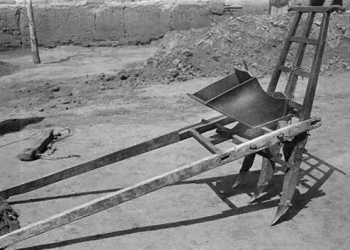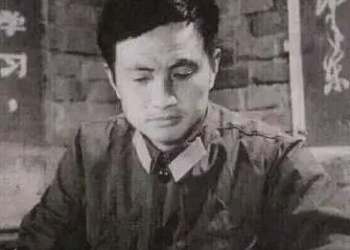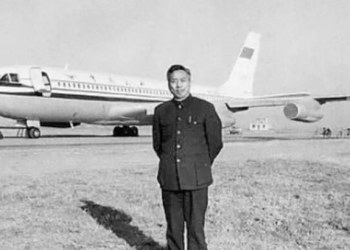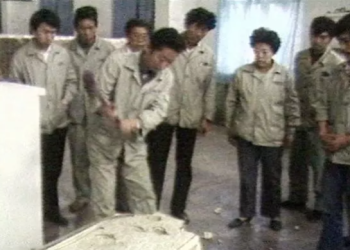In 1954, the United States launched the world’s first nuclear-powered submarine—the USS Nautilus—marking its emergence as the first country to master nuclear submarine technology. Compared to conventional submarines, nuclear submarines rely on power generated by nuclear reactors, allowing them to travel underwater at higher speeds and dive to greater depths. Unlike conventional submarines that must surface periodically to recharge and resupply, nuclear submarines can operate submerged for extended periods. It is said that American nuclear submarines at that time could remain underwater for up to 84 days, pushing the limits of contemporary U.S. technological capabilities.
Like the atomic bomb, the nuclear reactor that powers a nuclear submarine also relies on the principle of nuclear fission, using a special material known as uranium-235. However, the two are far from interchangeable. The reason is simple: while an atomic bomb detonates in the open spaces of deserts or remote test sites without spatial constraints, a submarine’s nuclear reactor must function within a confined compartment. It must also maintain over 130 critical operational parameters to ensure proper performance and maintain optimal power output.
Moreover, the radiation produced during nuclear reactions must be strictly contained to avoid endangering the submarine’s crew. The reactor must integrate seamlessly with complex onboard systems such as sonar, inertial navigation, air conditioning, and water supply. Even when the submarine experiences significant external shocks while submerged, the nuclear reactor must continue to operate reliably. And this is just the tip of the iceberg when it comes to the challenges of nuclear submarine development.
After the U.S. successfully launched its nuclear-powered submarine, the Soviet Union quickly followed with its own. However, due to the Soviet Union’s relatively weaker industrial foundation, many of its technologies were still in early stages, resulting in a series of technical setbacks. Nonetheless, this did not deter other countries—such as the United Kingdom and France—from joining the race to develop nuclear submarines.
In June 1958, with assistance from the Soviet Union, China built its first experimental nuclear reactor. At that time, China’s nuclear-related technologies were essentially starting from scratch. However, Marshal Nie Rongzhen, who was then in charge of national defense science and technology under the leadership of the Chinese Communist Party, clearly recognized the strategic necessity for China to develop nuclear submarines. That same month, he submitted a report to the central government proposing the launch of a nuclear submarine research program, which was taken very seriously by the top leadership.
China was determined to develop its own atomic bomb, and nuclear submarines could not be left behind. However, Soviet experts were extremely secretive when it came to nuclear weapons technology. For example, when Academician Qian Sanqiang attended a lecture by Soviet scientists on atomic bomb theory, the presenters acted mysteriously—writing and erasing notes repeatedly. In the end, the only information that could be retained was already publicly available abroad. If it was this difficult to obtain atomic bomb knowledge, acquiring technical data on nuclear submarines was even more challenging.
During the National Day celebrations in 1959, Soviet Premier Nikita Khrushchev visited China. Upon hearing about China’s intention to build nuclear submarines, he remarked—right in front of Chairman Mao Zedong—that nuclear submarine technology was too complex and expensive, implying that China simply wasn’t capable of achieving it.

This was undoubtedly a subtle warning for China to back down in the face of difficulty. However, Chairman Mao Zedong responded firmly during a central committee meeting, waving his hand decisively:
“Even if it takes us ten thousand years, China must build its own nuclear submarine.”
In 1958, China officially launched Project “09,” the nation’s first nuclear submarine development initiative. Under the leadership of the Central Military Commission, a multi-departmental task force was established to climb the monumental mountain that was the nuclear submarine. The Second Ministry of Machinery Industry was responsible for the nuclear propulsion system, while the First Ministry tackled the submarine’s hull and onboard equipment. The Navy also actively participated in the development process.
Some of the scientists and engineers assigned to the nuclear submarine program had previously visited the Soviet Union and had seen marine nuclear power systems firsthand, giving them basic insights into thermal engineering. A few had also examined and obtained some blueprints and technical materials related to the “Type 629” conventional-powered ballistic missile submarine, which served as valuable reference material for China’s nuclear submarine design. However, most of the team had never even seen a submarine before. They had to study and decipher the principles of nuclear submarines from foreign academic papers. Among them was Huang Xuhua, who would later become the chief designer of China’s first nuclear submarine.
In an interview during his later years, Academician Huang Xuhua recalled:
“A nuclear submarine is classified as top-secret. The foreign academic papers we relied on were often incomplete, with key parts deliberately omitted. Some even contained intentional misinformation mixed in with real data.”
Western papers often included traps—one example cited a paper that insisted submarines must be equipped with a massive, 60-ton gyroscope to ensure stability during underwater missile launches. However, every structural component on a nuclear submarine is rigorously calculated; there is no room for unnecessary weight. Chinese scientists, armed with nothing more than abacuses and hand-cranked calculators, spent countless hours poring over technical documents, eventually proving that such a gyroscope was entirely unnecessary.
Time was precious. Huang Xuhua and his colleagues raced against the clock, often working around the clock. Yet most of the researchers had not originally trained for this. They had to study and innovate simultaneously. Huang himself had graduated from the Department of Shipbuilding Engineering at Shanghai Jiao Tong University. Although submarines fall under the category of ships, the addition of nuclear propulsion presented entirely new technical challenges. China’s first chief designer of nuclear submarines, Academician Peng Shilu, had originally studied chemical machinery in Kazan, USSR, and only later shifted to nuclear engineering.
To better understand Western nuclear submarine technology, many had to wake up in the middle of the night to cram English vocabulary—since most of the available academic papers were in English.
Sometimes, success does not depend on whether conditions are ripe. Rather, it is the determination to accomplish something that drives the creation of those very conditions.
Unlike conventional submarines, nuclear submarines are powered by nuclear propulsion systems. In 1960, China completed the Preliminary Design Draft of the Nuclear Submarine Power Device. Soon after, Huang Xuhua traveled to Shanghai to search for a large enough water tank suitable for experimental testing of the submarine. Meanwhile, Peng Shilu and other experts were tirelessly calculating the precise data required for a nuclear reactor to operate at optimal power levels—laying the theoretical groundwork for turning the nuclear submarine from vision into reality.
However, in 1961, in line with the national strategy of “adjustment, consolidation, enrichment, and improvement,” the central government decided to streamline military efforts and focus on the development of the atomic bomb and missile systems. As a result, the nuclear submarine project was listed as an adjustment project. Only a small core team was retained to continue preliminary research and theoretical design focused on the nuclear power system. While some felt disheartened, Peng Shilu remained resolute, continuing to gather data on reactor operation while also training the technical talents needed for the submarine program. In his later years, Peng recalled:
“If we hadn’t retained these professionals at the time, developing a nuclear submarine would have been extremely difficult.”
He firmly believed that the suspension of the nuclear submarine project was only temporary. China would eventually master the atomic bomb, and when that happened, nuclear submarines would return to the national agenda.
History later validated Peng’s foresight. In 1964, China successfully detonated its first atomic bomb at Lop Nur. Many scientists and engineers involved in that project gained valuable knowledge and experience regarding nuclear reactor systems—lessons that would prove essential to the eventual development of nuclear submarines. As China’s internal and external conditions improved, the central government refocused its attention on nuclear submarines.
In 1965, Premier Zhou Enlai personally chaired a meeting of the Central Special Committee, where the decision was made to resume the nuclear submarine project. This marked the formal restart of China’s nuclear submarine development. The Second Ministry of Machinery was once again tasked with developing the nuclear propulsion system—laying the foundation for what would later become the China Nuclear Power Research and Design Institute.
Scientists from across the country gathered once more, exchanging information and discussing nuclear submarine design proposals based on the materials they had studied. Huang Xuhua advocated for a “teardrop-shaped” hull design, known for its smooth, rounded surface and minimal resistance during deep-sea navigation. However, many experts opposed the idea, arguing that China should first adopt the more familiar streamlined shape of conventional submarines before transitioning to a teardrop form.
It was Marshal Nie Rongzhen who ultimately settled the debate. He supported Huang’s vision, stating that nuclear submarines should be fundamentally different from conventional ones. At a key meeting in 1966, Nie endorsed the teardrop design, putting an end to the controversy.
In December 1966, the “teardrop-shaped design proposal” for China’s first nuclear submarine, Project “091,” received official approval from the central government. The sea trial date was set for 1970. In early 1968, the National Defense Science and Technology Commission established a Nuclear Submarine Project Office to handle overall coordination and command. Then in October 1969, the State Council and the Central Military Commission jointly decided to form a dedicated leadership group for the nuclear submarine project, accelerating the journey toward China’s first nuclear submarine.
When all preparations were finally complete and it was time for formal assembly, Huang Xuhua noticed something troubling: some researchers had trimmed away excess materials during installation, and surplus pipes and cables were left scattered on the floor. Realizing the importance of such details, he insisted that every piece of leftover material removed from the nuclear submarine be weighed and accounted for. Years later, Huang candidly told reporters that his insistence on weighing every scrap may have seemed overly meticulous or even “old-fashioned,” but during that era of limited resources—where every step had to be figured out from scratch—such “old-fashioned” methods were the most rigorous and reliable approach.
On December 26, 1970, China’s first nuclear submarine was successfully launched in Huludao, bearing the hull number 401. After further refinements, in 1974, the submarine was officially commissioned into the Chinese Navy and named Long March No. 1 (Changzheng Yi Hao).

China’s nuclear submarine program had finally “emerged from the clouds to see the moon,” yet just like the name of its first nuclear submarine—Long March No. 1—the long march had only just begun. In 1988, China successfully conducted its first underwater launch test of a ballistic missile submarine. That same April, Academician Huang Xuhua personally accompanied the submarine crew as they dove to a depth of 300 meters beneath the South China Sea—and even slightly beyond—achieving a historic breakthrough that greatly boosted the morale of both researchers and naval personnel.
Today, though the man himself is gone, the hardships and triumphs of China’s nuclear submarine development continue to be honored and remembered by generations to come.











